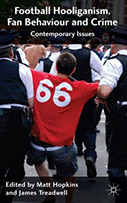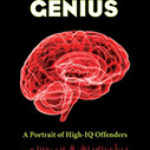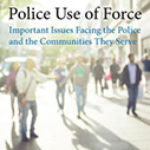Football Hooliganism, Fan Behaviour And Crime: Contemporary Issues

Editors: Matt Hopkins and James Treadwell
Publisher: London; New York: Palgrave Macmillan, 2014. 328p.
Reviewer: Ellis Cashmore | January 2015
The apocalyptic reverie of violence, apparently devoid of intelligible purpose, that frequently accompanies games of soccer in Europe, South America and beyond, puzzles American fans. For at least a half-century, soccer has been the scene of blood-drenched tableaux ablaze with emotion, often punctuated by song and usually climaxing in acts of visceral conflict. “How can sports fans get so agitated about what is, after all, a sports competition?” a US fan might ask. They seem to be attempting a kind of cathartic purge of bottled-up aggression. Or maybe imaginatively recounting conflicts of generations past. They fight like animals that have suddenly discovered the cage door has been left unsecured. They appear bent on a near-genocidal mission to slay people they neither know, nor want to know, but who are antagonists by virtue of their support for some team or other.
Incredulous fans are not the only ones bewildered by the long and powerful passage of violence that is now endemic in soccer. Other sports have witnessed sporadic incidents of conflict, but soccer’s violence is an integral feature of its makeup. It is unique. Scholars have pondered the phenomenon since the early 1970s. Yet the precise reasons for what became known – rightly or wrongly — as hooliganism remain opaque.
Matt Hopkins and James Treadwell are criminologists at English universities. They have assembled twelve contributions from British scholars, all with research backgrounds, in an effort to render violence transparent. The title Football Hooliganism, Fan Behaviour and Crime: Contemporary Issues suggests this is intended primarily for a non-US readership. Football, of course, refers to association football – “soccer” is probably an abbreviation of “assoc” +er. So, from this point, I’ll stick with the editors and use “football.” They write that the decades of academic attention afforded the particular type of disorder connected with football, “makes football unique in having a specific label that can be applied to any disorderliness or violence that is seemingly linked to it (that being football hooliganism)” (p. 4).
The etymology of the word hooligan is vague: the editors trace its origins to a nineteenth century English word to describe gangs of violent youths. While the editors do not mention it, a common story is that it derives from the family name of a fictional rowdy Irish family in a music hall (a sort of vaudeville) song of the 1890s. One of my guilty pleasures is Sherlock Holmes, so I happen to know that Conan Doyle, in The Adventure of the Six Napoleons, first published in 1904, quotes Inspector Lestrade of Scotland Yard, when commenting on apparent vandalism: “It seemed to be one of these senseless acts of Hooliganism which occur from time to time, and it was reported to the constable on the beat as such.” (Note the capital H.)
Hopkins and Treadwell present three themes that guide the organization of their book. The first is what they term “football as a crime generator.” The phrase suggests the sport is an apparatus for converting forms of energy into criminal activity. This is not far away from the intended meaning. “Football matches are places that offenders go to because they are aware of the existence of crime opportunities,” write the editors (p. 11).
The second theme is “Exploring fan behavior in the global media age.” In the 1960s and 1970s, sociologists were drawn to the idea that the mass media, as it was then called, had created hooliganism. Influenced by the Leslie T. Wilkins’ deviancy amplification spiral, researchers argued that, in covering episodes of violence and applying a unifying label, newspapers and, to a lesser extent, broadcast media increased awareness of and interest in the phenomenon and, in time, gave shape to it.
The third theme is “Criminalisation, control and crowd management.” The watershed moment was, as many readers will already know, Hillsborough. This is an iconic tragedy is football’s history: 96 fans were fatally injured during an FA Cup semi-final in Sheffield between Liverpool and Nottingham Forest on 15 April 1989. The investigation into its causes and arguments over blame continue to the present day.
Despite the orderly intent, the book is like an unmade bed: rumpled, inchoate and uneven. Some of the contributions are as welcome as fresh linen, while others are like well-punched pillows. For example, the chapter on “Football as a crime generator” presents topography of crime in and around football stadiums. Loaded with graphs, maps, figures and formulae, it is offers a “spatial analysis” of criminal activity in Leeds, in the north of England, which may be useful to police and associated enforcement agencies, but not necessarily to anyone else. “There is little doubt that matches increase levels of crime,” write Justin Kurland et al. But their approach is policy and police-oriented and no space is given to explaining, less still understanding, why certain forms of behavior that, in another context might be regarded as boisterousness or tempestuously rough quarrelling become designated “football-related crime.”
The very next chapter, written by the editors themselves, is an ethnographic account of the use of cocaine by football gangs, or firms, as they are more usually called. For decades, hooliganism has been assumed to be related, perhaps even causally, with alcohol consumption. Treadwell and Ayres suggest, “cocaine is often the football hooligan’s drug of choice because it helps individuals perform as better and more ferocious fighters, while providing the courage and clarity of mind needed to engage in confrontation” (p. 51). It almost sounds like an endorsement!
The chapter is consistent with the editors’ intention, i.e. “considering football hooliganism as simply a context to consider wider aspects of criminal enterprise,” as opposed to identifying and analyzing forms of deviance that have not just taken place in the context of football, but have their sources and their commission in the football experience.
While the chapter on cocaine use and supply is based solely on conversations with one self-proclaimed hooligan, the authors James Treadwell and Tammy Ayres argue: “The football firm and membership of it are an excellent proving ground for an array of masculine virtues and for forms of gendered social capital that are requisites and competencies of crime generally” (p. 68). They go on to conclude hooliganism provides a set of skills, though ones that are of no value outside the “criminal milieu.”
The organic rebel energy of football has been growing since the start of the twentieth century, but, as John Flint and Ryan Powell point out, sectarian divisions made the violence in Scotland comprehensible. The Protestant-Catholic conflict in Ireland was often played, or fought out in Glasgow and beyond by fans of clubs borne of denominational tradition. Celtic, of Glasgow, and Hibernian, of Edinburgh, as their names indicate, were founded as Irish Roman Catholic institutions.
In another chapter, Stuart Walton revisits the phenomenon: “That’s the whole point about being a fan. You are tribal and irrationally loyal” (p. 205). The statement contrives to be both credible and unhelpful. Why? Nowhere in the book is the reader invited to understand the creativity of hooliganism: surely, amid the ostensibly irrational and unthinkingly tribal fighting there is some meaningful productive activity or a hedonistic pursuit of satisfaction others find unimaginable. Walton’s is the only chapter in this collection to puncture what he calls the “Elitist contempt for football fans.” He is critical of how the police, in concert with other authorities, have tried to “sanitise,” as he calls it, what was and remains perhaps immovably a rough sport. Fans have been criminalized, Walton argues; and, while he does not define what he means, I assume he is suggesting that activities that were once part of the warp and weft of an industrial working class sport have been turned into criminal offences. A later chapter, by Clifford Stott, returns to the question of how engaging in collective aggression contributes to building identities, but the many threads are left as errant strands, leaving the reader with more questions than answers.
A chapter by Graham Brooks on the white-collar crimes of football – corruption, bribery, and matchfixing – seems to have strayed in from another book. Interesting as the subject certainly is, why is it in a volume on hooliganism? Maybe the author believes we should inflate the term to include miscreants in the boardroom.
Chapters on the publishing and film industries that have grown around hooliganism are interesting sidebars. And a chapter on Hillsborough tells us nothing more than anyone familiar with the tragedy will already know. The editors never seem sure whether they wish to present a cogent understanding of the origins, development, and reasons for football hooliganism, or a package of strategies for controlling it. This is potentially great subject matter, especially in today, when violence at football appears to have gone global and manifested in Africa and Asia. But the editors seem to have allowed their contributors carte blanche and, as is often the case with edited collections, there is little unity of purpose, just an aggregation of chapters on the same subject.
Ellis Cashmore is visiting Professor of Sociology at Aston University, UK. His twitter account is @elliscashmore


